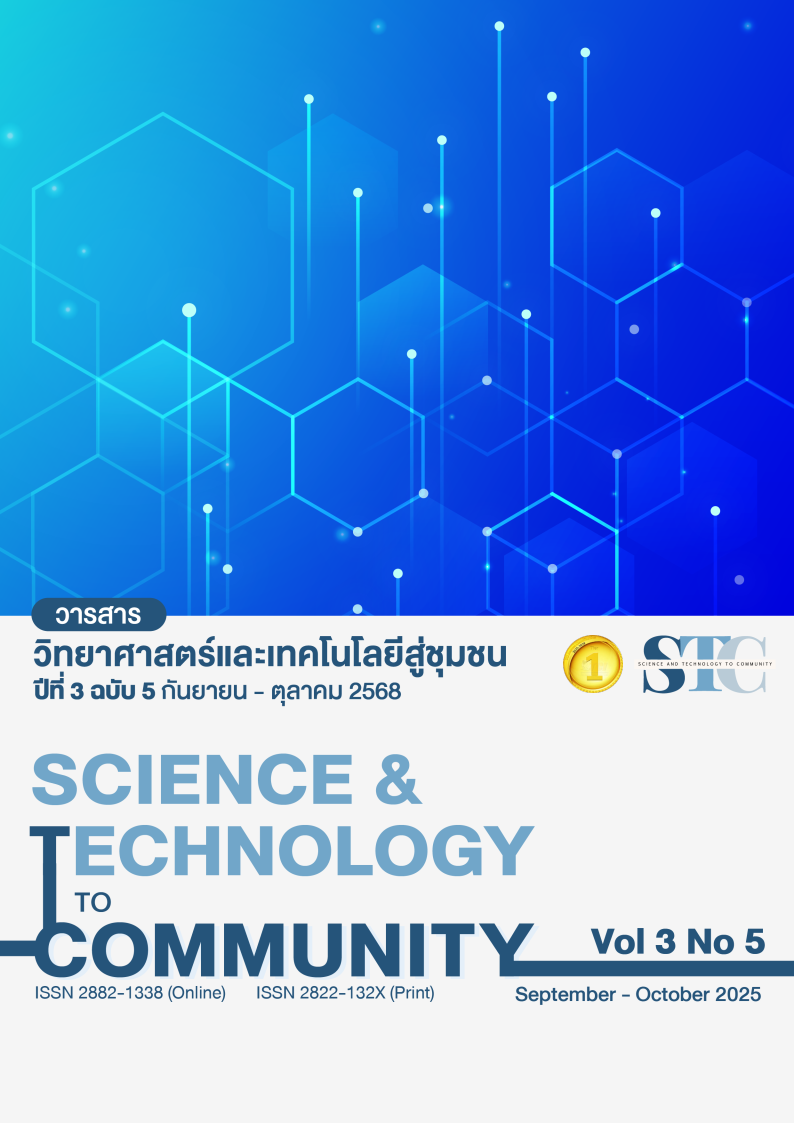การปนเปื้อนของเชื้อสเตรปโตคอคคัส ซูอิส ในเนื้อ อวัยวะ และเลือดของสุกรจากตลาดค้าปลีกในจังหวัดพะเยา ประเทศไทย
DOI:
https://doi.org/10.57260/stc.2025.1096คำสำคัญ:
เชื้อสเตรปโตคอคคัส ซูอิส , การปนเปื้อน , เนื้อสุกรดิบ , อวัยวะสุกร , จังหวัดพะเยาบทคัดย่อ
สเตรปโตคอคคัส ซูอิส (Streptococus suis; S. suis) เป็นเชื้อก่อโรคสำคัญในมนุษย์ โดยสามารถก่อให้เกิดการติดเชื้อได้ง่ายเมื่อสัมผัสโดยตรงกับสุกรหรือผลิตภัณฑ์จากสุกรที่ปนเปื้อน ซึ่งเป็นสาเหตุของโรคติดต่อจากสัตว์สู่คนได้ การศึกษาในครั้งนี้มีวัตถุประสงค์เพื่อประเมินการปนเปื้อนของเชื้อ S. suis และ S. suis ซีโรไทป์ (serotype) 2 หรือ 1/2 ในเนื้อสุกรบด เนื้อสันใน อวัยวะภายในของสุกร ได้แก่ หัวใจ ตับและเลือด จากตลาดค้าปลีกในจังหวัดพะเยา ประเทศไทย ทำการเพาะเลี้ยงเชื้อจากตัวอย่างทั้งหมดใน Todd-Hewitt broth ที่มี Streptococcus Selective Supplement และตรวจหา S. suis และ S. suis ซีโรไทป์ 2 หรือ 1/2 ด้วยเทคนิค Multiplex polymerase chain reaction (PCR) จากจำนวน 66 ตัวอย่าง พบการปนเปื้อนของ S. suis และ S. suis ซีโรไทป์ 2 หรือ 1/2 คิดเป็นร้อยละ 62.1 และ 15.2 ตามลำดับ โดยพบการปนเปื้อนในตัวอย่างเลือดมากที่สุด การศึกษานี้แสดงให้เห็นถึงความเสี่ยงในการติดเชื้อ S. suis จากการบริโภคเนื้อสุกรและอวัยวะสุกรที่ไม่ผ่านการปรุงสุก การทำงานใกล้ชิดหรือสัมผัสกับเนื้อสุกรดิบ และอวัยวะสุกร ดังนั้นควรส่งเสริมการรณรงค์ด้านความปลอดภัยของอาหาร เพื่อป้องกันและควบคุมการแพร่กระจายของเชื้อ
Downloads
เอกสารอ้างอิง
กรมควบคุมโรค. (2567). สถานการณ์โรคสเตร็ปโตคอคคัสซูอิส (Streptococcus suis). https://ddc.moph.go.th/disease_detail.php?d=107
ยุพิน ศุพุทธมงคล, ปฐมาพร เอมะวิศิษฏ์, อนุพงค์ สุจริยากุล และ รัตนา ธีระวัฒน์. (2565). แนวทางการป้องกันควบคุมโรคสเตร็พโตค็อกคัส ซูอิส. (พิมพ์ครั้งที่ 2). กรุงเทพมหานคร: อักษรกราฟฟิคแอนด์ดีไซน์.
Boonyong, N., Kaewmongkol, S., Khunbutsri, D., Satchasataporn, K., & Meekhanon, N. (2019). Contamination of Streptococcus suis in pork and edible pig organs in central Thailand. Vet World, 12(1), 165-169. https://doi.org/10.14202/vetworld.2019.165-169
Gottschalk, M., Higgins, R., & Boudreau, M. (1993). Use of polyvalent coagglutination reagents for serotyping of Streptococcus suis. Journal of Clinical Microbiology, 31(8), 2192-2194. https://doi.org/10.1128/jcm.31.8.2192-2194.1993
Goyette-Desjardins, G., Auger, J. P., Xu, J., Segura, M., & Gottschalk, M. (2014). Streptococcus suis, an important pig pathogen and emerging zoonotic agent-an update on the worldwide distribution based on serotyping and sequence typing. Emerg Microbes Infect, 3(1), e45. https://doi.org/10.1038/emi.2014.45
Guntala, R., Khamai, L., Srisai, N., Ounjaijean, S., Khamduang, W., & Hongjaisee, S. (2024). Contamination of Streptococcus suis and S. suis serotype 2 in raw pork and edible pig organs: A public health concern in Chiang Mai, Thailand. Foods, 13(13), 2119. https://doi.org/10.3390/foods13132119
Hatrongjit, R., Kerdsin, A., Gottschalk, M., Takeuchi, D., Hamada, S., Oishi, K., & Akeda, Y. (2015). First human case report of sepsis due to infection with Streptococcus suis serotype 31 in Thailand. BMC Infect Dis, 15, 392. https://doi.org/10.1186/s12879-015-1136-0
Jiemsup, S., Lunha, K., Chumpol, W., Meekhanon, N., Kerdsin, A., & Yongkiettrakul, S. (2025). Development of a high-throughput MassARRAY-based single assay for the characterization of Streptococcus suis species and serotypes. Scientific Reports, 15, 7822. https://doi.org/10.1038/s41598-025-92524-5
Kerdsin, A. (2022). Human Streptococcus suis Infections in Thailand: Epidemiology, clinical features, genotypes, and susceptibility. Tropical Medicine and Infectious Disease, 7(11), 359. https://doi.org/10.3390/tropicalmed7110359
Lunha, K., Chumpol, W., Samngamnim, S., Jiemsup, S., Assavacheep, P., & Yongkiettrakul, S. (2022). Antimicrobial Susceptibility of Streptococcus suis Isolated from diseased pigs in Thailand, 2018-2020. Antibiotics (Basel), 11(3), 410. https://doi.org/10.3390/antibiotics11030410
Marois, C., Bougeard, S., Gottschalk, M., & Kobisch, M. (2004). Multiplex PCR assay for detection of Streptococcus suis species and serotypes 2 and 1/2 in tonsils of live and dead pigs. Journal of clinical microbiology, 42(7), 3169-3175. https://doi.org/10.1128/jcm.42.7.3169-3175.2004
Noppon, B., Khaeng, S., Sopa, A., Phuaram, P., Wongsan, R., & Laohasinnurak, T. (2014). Streptococcus suis serotypes 2 in uncooked pork meat products in Khon Kaen, Northeastern Thailand, and their antimicrobial profiles. International Journal of Scientific and Engineering Research, 5(9), 1130-1133.
Rayanakorn, A., Katip, W., Goh, B. H., Oberdorfer, P., & Lee, L. H. (2019). Clinical manifestations and risk factors of Streptococcus suis mortality among northern Thai population: retrospective 13-year cohort study. Infection and Drug Resistance, 12, 3955-3965. https://doi.org/10.2147/IDR.S233326
Segura, M., Aragon, V., Brockmeier, S. L., Gebhart, C., Greeff, A. D., Kerdsin, A., O’Dea, M. A., Okura, M., Saléry, M., Schultsz, C., Valentin-Weigand, P., Weinert, L. A., Wells, J. M., & Gottschalk, M. (2020). Update on Streptococcus suis research and prevention in the era of antimicrobial restriction: 4th International Workshop on S. suis. Pathogens, 9(5), 374. https://doi.org/10.3390/pathogens9050374
Subuttamongkol Y, Amavisit, P., Sujariyakul, A., Theerawat, R. (2022). Guidelines for prevention and control of Streptococcus suis. Bangkok: Aksorn graphic and design publishing house limited partnership.
Thongkamkoon, P., Kiatyingangsulee, T., & Gottschalk, M. (2017). Serotypes of Streptococcus suis isolated from healthy pigs in Phayao Province, Thailand. BMC Res Notes, 10(1), 53. https://doi.org/10.1186/s13104-016-2354-2
ดาวน์โหลด
เผยแพร่แล้ว
รูปแบบการอ้างอิง
ฉบับ
ประเภทบทความ
สัญญาอนุญาต
ลิขสิทธิ์ (c) 2025 วารสารวิทยาศาสตร์และเทคโนโลยีสู่ชุมชน

อนุญาตภายใต้เงื่อนไข Creative Commons Attribution-NonCommercial-NoDerivatives 4.0 International License.
1. บทความ ข้อมูล เนื้อหา รูปภาพฯลฯ ที่ได้รับการตีพิมพ์ใน “วารสารวิทยาศาสตร์และเทคโนโลยีสู่ชุมชน” ถือเป็นลิขสิทธิ์ของวารสารวิทยาศาสตร์และเทคโนโลยีสู่ชุมชน มหาวิทยาลัยราชภัฏเชียงใหม่ หากบุคคลหรือหน่วยงานใดต้องการนำทั้งหมดหรือส่วนหนึ่งส่วนใดไปเผยแพร่ต่อหรือกระทำการใดๆ จะต้องได้รับอนุญาตเป็นลายลักษณ์อักษรจาก วารสารวิทยาศาสตร์และเทคโนโลยีสู่ชุมชน มหาวิทยาลัยราชภัฏเชียงใหม่
2. เนื้อหาบทความที่ปรากฏในวารสารเป็นความรับผิดชอบของผู้เขียนบทความโดยตรง ซึ่งกองบรรณาธิการวารสารไม่จำเป็นต้องเห็นด้วยหรือร่วมรับผิดชอบใดๆ














